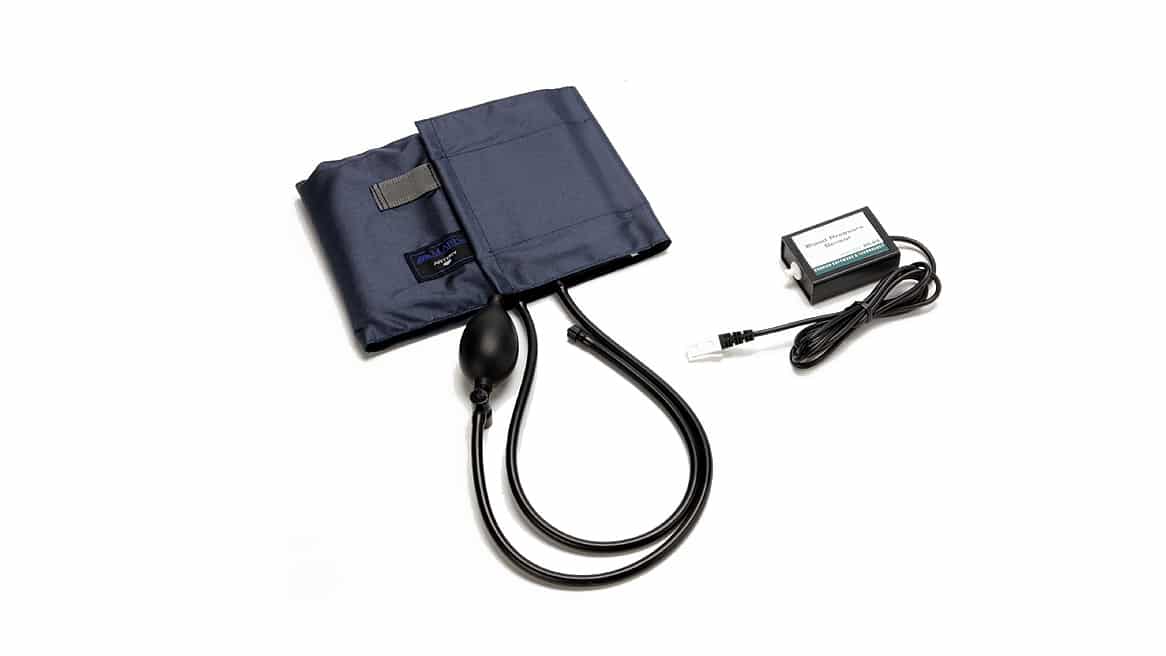Troubleshooting
- The Blood Pressure Sensor will not report blood pressure parameters unless data collection has started.
- The data-collection software needs to finish collecting data in order to get accurate blood pressure readings. Do not stop data collection prematurely; allow the software to complete data collection.
- Primary Test: Confirm that the software is the newest version (Logger Pro, LabQuest App, Graphical Analysis etc). Confirm that the sensor is set up correctly. The cuff should be positioned over the upper arm just above the elbow. The two rubber hoses from the cuff should be positioned over the bicep muscle (brachial artery) and not under the arm. Tighten the cuff on the arm using the attached hook-and-pile strip. You want the cuff to fit snug when no air is in it.
- The readings displayed on the computer screen should be between 0 and 5 mm Hg before any air is pumped into the cuff.
- Squeezing the rubber bulb repeatedly, inflate the cuff to a pressure between 150 and 170 mm Hg. When this maximum pressure is achieved, place the rubber bulb on the desk. The built-in release valve will automatically deflate the cuff at a constant rate.
- The exhaust rate should be between 2.0 and 4.0 mm Hg/s. If the cuff is not releasing the air or not releasing the air fast or slow enough, refer to the Specifications and User Guide for instructions on “Adjusting the Pressure Release Valve”.
- If the cuff will not deflate, check to see that the pressure release valve is not completely closed. It should be opened about four turns from the closed position.
- An appropriate-sized cuff is required for the subject to obtain accurate results. The small cuff fits subjects with upper arm circumferences between 18.4 and 26.7 cm (CUFF-SM). The standard adult cuff accommodates upper arms between 27.9 and 41.7 cm. For large upper arms with circumferences between 33 and 50.8 cm, the large cuff should be used (CUFF-LG).
Is it a problem if the readings are not consistent? Blood pressure readings will differ from person to person and even between measurements on the same individual. Do not expect to receive the same measurements each trial since there are many factors that cause a person’s blood pressure to increase or decrease.
Additional Troubleshooting
- Why are blood pressure readings unrealistic or not being reported by the software?
- My blood pressure readings do not update after the first run when using LabQuest 2, even though the new graph appears on the screen.
Specifications
- Sensing element: SSCMRRN005PGAA5
- Pressure range: 0 mm Hg to 258 mm Hg
- Maximum pressure without permanent damage: 1550 mm Hg
- Typical accuracy: ± 1 mm Hg
- Temperature compensated: –20°C to 85°C
- Combined linearity and hysteresis: typical ±0.25% full scale range
- Response time: 1 millisecond
- Calibration
⚬ slope: 64.64 (mm Hg/V)
⚬ intercept: –32.32 (mm Hg)
Calibration
Calibrate? No. This sensor cannot be calibrated.
Related Products
- Smaller cuff, Blood Pressure Cuffs (
CUFF-SM ) - Standard cuff, Blood Pressure Cuffs (
CUFF-STD ) (included) - Larger cuff, Blood Pressure Cuffs (
CUFF-LG ) - Go Direct® Blood Pressure Sensor (
GDX-BP )

